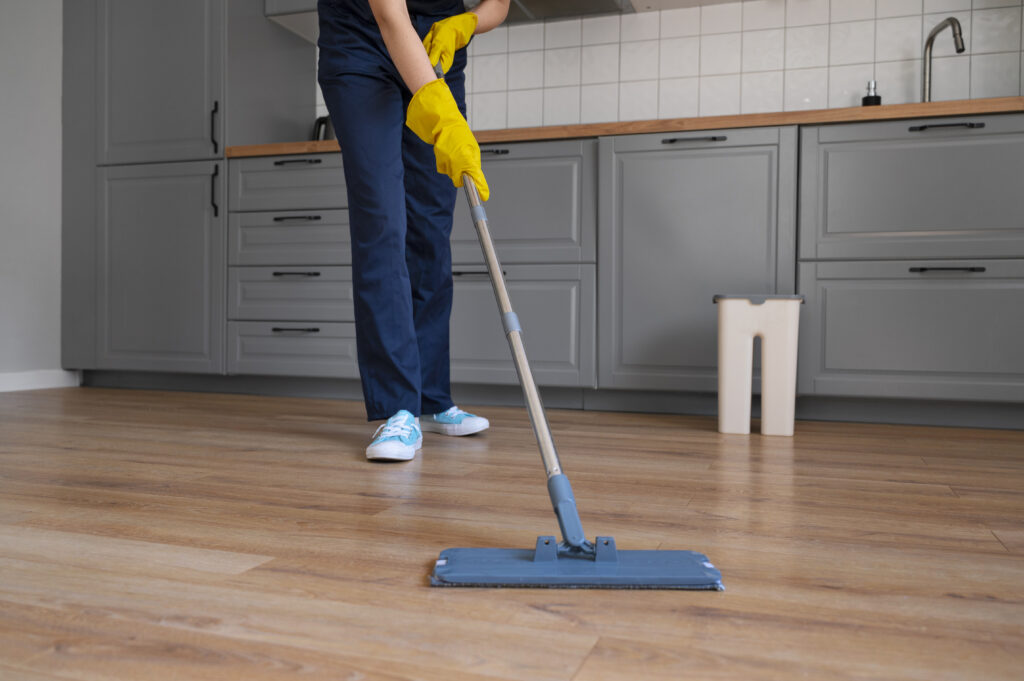After the installation of an LVT (Luxury Vinyl Tile) or LVP (Luxury Vinyl Plank) floor, regular cleaning and maintenance are crucial to ensure its longevity and prevent potential issues. When performing maintenance and cleaning on LVT and LVP resilient flooring, it’s imperative to adhere to the manufacturer’s specific instructions and guidelines. Using the manufacturer’s recommended cleaning products is also essential to maintain the warranty’s validity. These manufacturer-provided instructions take precedence over generic industry standards and should be part of the post-installation service provided to the consumer.
Maintenance tasks for LVT and LVP flooring can be divided into daily, weekly, and monthly routines. A comprehensive cleaning regimen often involves removing dressing or wax buildup and other cleaning agents, with the aim of restoring the flooring to its original factory surface, followed by the application of new dressings or wax.
The first line of defense in maintenance is the use of walk-off or entry mats placed on both sides of exterior entries before the LVT/LVP flooring. These mats should be cleaned daily by sweeping or vacuuming. Weekly, they should undergo a thorough cleaning using water and an appropriate cleaning agent. It’s crucial to consider the type of fiber in the mat, whether it’s olefin or nylon, as these fibers have different properties concerning liquid absorption and pH tolerance.
For the LVT/LVP floor itself, whether it’s a glue-down or floating system, daily maintenance involves dusting and dry mopping, with vacuuming as needed based on usage, such as heavy foot traffic and the presence of pets. Be cautious not to shake out dirt, soil, or debris indoors; instead, vacuum the mop head to control dust effectively.
When dealing with soiled areas on the floor, determine whether they require a water-based or solvent-based cleaner. For water-based cleaners, you can either spray the area directly for small spots or apply the spray to a cleaning cloth first for larger areas. When using a solvent-based cleaner to clean up oil or grease, apply the spray to a cleaning cloth. Avoid using vinegar or lemon-based products, as these mild acids can damage the surface layer. Oil-based products like Murphy’s Oil can create a slippery surface.
Avoid heavy, concentrated rubbing with the cleaning cloth. First, blot the soiled area and then gently swipe with the cloth to complete the cleaning. Keep in mind that a water-based cleaner will not effectively remove an oil or grease-based stain, including adhesive or sealer oozing from joints. If the stain is organic, such as from a food spill or pet accident, gently remove the bulk of the material with a scraper before cleaning with the agent and cloth. In joint areas, vacuuming during or after cleaning may be necessary. Use a soft bristle brush for brushing to prevent surface layer damage.
In larger open spaces and commercial areas, a common cleaning method is using a rotary machine with an attached pad (white or green, depending on the flooring product). When applying a cleaning agent with a string mop, be cautious not to saturate the flooring with liquid, as this can cause damage. NEVER use a saturated mop on a floating floor; the mop should only be slightly damp. A wet vacuum can be used to remove excess liquid, followed by the use of a string mop and possibly air movers. Once the surface is clean and dry, dressing can be applied and buffed to achieve the desired finish.
Nationally advertised cleaning systems are effective but must be used with care to avoid over-wetting. Leaving a steam jet on floating floor joints for too long can introduce moisture, potentially damaging the core. Whether the flooring is WPC or SPC, prolonged moisture exposure is not advisable.
Finally, a crucial point from the installation perspective: using a rubber mallet to install a click system or align planks may create a permanent spot. The friction between the rubber mallet and the vinyl layer of the plank can fuse rubber particles onto the plank surface, which is difficult to remove, if at all. It’s important to manage customer expectations regarding this potential issue.
Attribution: This content is based on information from ProInstaller Magazine.



